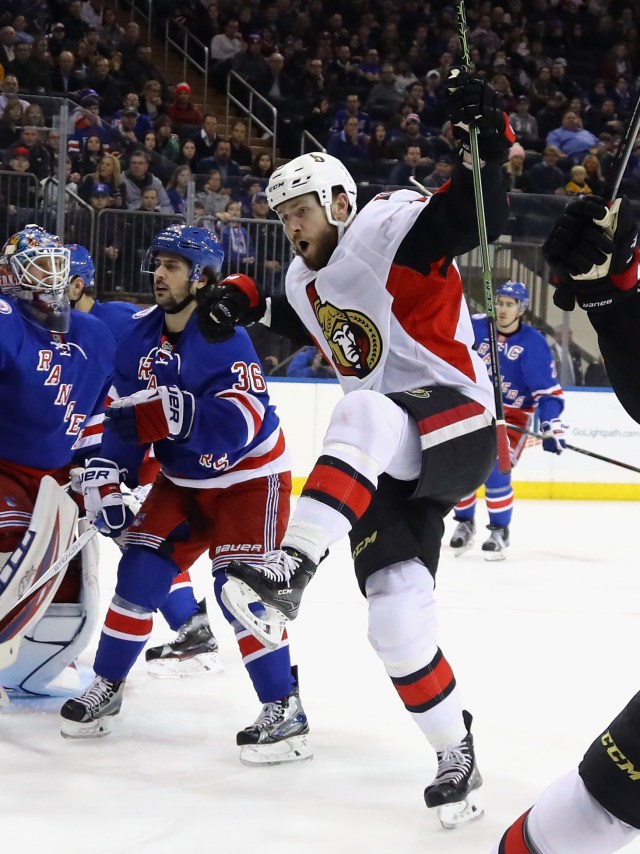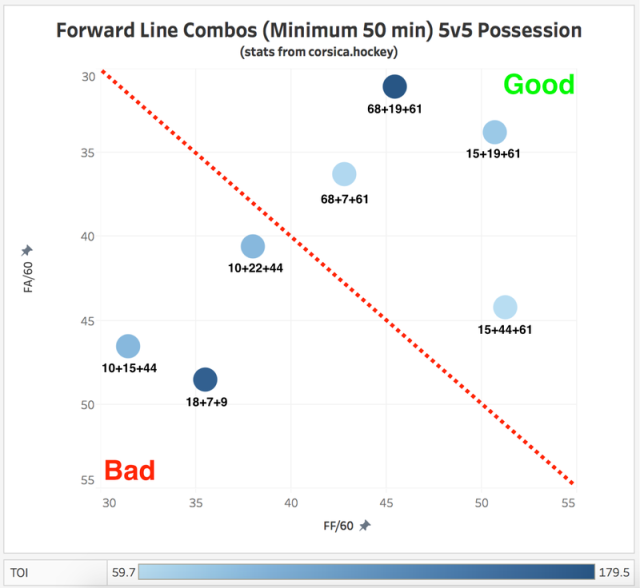
Zack Smith is renowned for two things: 1) the shit-eating grin that he displays during each on-ice scrum; and 2) possessing this blend of physicality and modest offensive talent that not only endears himself to his coaches but to this team’s fans as well.
As an impending unrestricted free agent, Smith’s future with the club has been the subject of conversation going back as far as last season when he improbably scored a career-high 25 goals.
In the last year of four-year contract that he signed in September of 2012 that pays him $2.35-million (with an average annual contract value of $1.8875-million), the question of what to do with Smith will only intensify as the Senators approach the trade deadline.
The Senators currently sit in third place in the Atlantic Division with 46 points and are in a midst of the Eastern Conference playoff race, so it’s hard to imagine the Senators’ philosophy changing since have ever really made a habit of trading impending free agents or selling high on players at the deadline.
Rather than trade impending free agents or let them hit free agency, the organization has taken pride in its ability to re-sign its own players – which invites the question: how much should the Senators be looking to pay Zack Smith?
Postmedia’s Ken Warren kicked around the idea of a Smith contract extension in today’s Ottawa Sun, suggesting that the versatile winger could command a $4-million salary.
Is he worth it?
Probably not.
I like Zack Smith and the flexibility he provides, but not at that cost.
Smith posted some low double-digit goal totals earlier in his career, but thanks to possessing a decent shot, there was always been some intrigue in wondering whether he could be capable of more.
At the start of the 2014-15 season, Paul MacLean elected to use Smith in a top-six capacity at the expense of Mika Zibanejad. Like a few other veterans who struggled in expanded roles, Smith’s production and play failed to justify his role.
Eventually a wrist injury would sap Smith’s strength and confidence that season and after spending time on the team’s fourth line, Smith fell into the trap of playing a conservative dump and chase style.
Last season however, Smith not only benefited from riding shotgun to some players who have no problems carrying and distributing the puck, but he rode the percentages as well.
B by scoring 25 goals on 121 shots (20.4), Smith essentially doubled his regular season high for shooting percentage (10.4) that he set in the 2011-12 season when he scored 14 goals for his previous career high.
It’s pretty rare for a shooter to score that many goals when he shoots so infrequently, but even Smith’s numbers this season – nine goals on 72 shots (12.4) – put him ahead of his career norms.
Smith should never be regarded as a 20-goal guy, but there’s definitely utility there.
The real danger for Senators management is committing term and money to a player who not only will turn 29-years old this April, but whose inflated production is intrinsically linked tied to playing alongside Mark Stone.
Courtesy of HockeyAnalysis.com, here’s a table depicting how Stone has fared playing with and without Stone at five-on-five over the past two seasons:
| TOI | GF60 | GA60 | GF% | CF60 | CA60 | CF% | |
| With Stone | 604:15 | 2.58 | 1.69 | 60.5 | 64.34 | 53.12 | 54.8 |
| Without Stone | 813:37 | 2.06 | 1.92 | 51.9 | 50.96 | 58.70 | 46.5 |
Granted, Ottawa’s depth has kind of sucked the past two years and it’s understandable why Smith’s numbers would plummet playing with lesser quality players, but that also ignores how much Stone’s presence improves the performance of his linemates.
A simple glance at Stone’s ‘With or Without You Numbers’ corroborates this and if you’re into visuals, today’s piece on Silver Seven which examines the performance of the Smith-Brassard-Stone line included a graph which helps plainly identify Stone as an integral factor for success.
None of that should be new for fans who watch this team regularly, but his ability to influence the production and play of his fellow winger raises a crucial point: should the Senators allocate relatively significant resources to re-sign Zack Smith?
It’s not like this is a relatively new phenomenon, the play and performance of Jason Spezza didn’t come without a cost. His brilliance resulted in contract extensions to classic pump and dump candidates like Milan Michalek and Colin Greening – players whose untenable production normalized over the years that followed.
The emergence of players like Ryan Dzingel and Mike Hoffman has bolstered the left side and realistically, both should slot ahead of Smith in the lineup. Management has also been pretty adamant that Clarke MacArthur will return and play games this season. Granted, he last played in a regular season game in October of 2015, so it’s not like the Senators can exactly bank on MacArthur’s long-term health here. But, if he ever gets a clean bill of health and steps in, he’s a well-rounded player who brings more to the table than Smith.
Even without MacArthur however, it seems reasonable to assume that a prospect like Colin White will step into the lineup at the conclusion of his season at Boston College – whether it’s this season or next fall remains to be seen, but his presence should mitigate a prospective Smith departure.
The other real danger for management is committing too many dollars and term to Smith when its better and younger players come off their inexpensive second contracts in the forthcoming years and require raises of their own. The last thing the organization needs is to run out of resources and be put in situations in which it has to move out talented young players and draft picks to acquire players who guarantee cost certainty. Oh hey, Derick Brassard. Didn’t see you there.
Barring a miracle, the contracts to Phaneuf and Ryan aren’t going anywhere anytime soon and as a small market team, the Senators can ill afford to pay a quarter or third of its player budget paying for diminished returns from this trio.
There are better ways to allocate its resources.
Add The Sports Daily to your Google News Feed!
